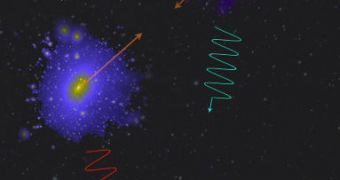About 40 years ago, astrophysicist Rashid Sunyaev and advisor Yakov Zel'dovich predicted that the Cosmic Microwave Background (CMB) radiation is influenced by interactions with moving galaxy clusters. The kinematic Sunyaev-Zel'dovich (kSZ) effect was finally confirmed in a new study.
The researchers originally suggested that the imprint on the CMB would be very subtle, but the limited technological means at their disposal at the time prevented them from investigating their idea in any meaningful way.
By combining data from two important international astronomy collaborations, Princeton University undergraduate student Nick Hand and advisor David Spergel were recently able to confirm the idea.
In order to do that, the group combined readings from the Atacama Cosmology Telescope (ACT) with data compiled during the third Sloan Digital Sky Survey (SDSS-III). Hand is now a graduate student at the University of California in Berkeley (UCB).
He was the first author of a paper describing the study. The work was published online in the journal arXiv, and was also submitted for publication in an upcoming print issue of the esteemed journal Physical Review Letters.
The 58 authors on the new paper believe that this type of work has the potential to provide us with a deeper understanding of how the Universe is set up, as well as reveal how large galaxy clusters are formed. “It's an exciting confirmation of an effect first theorized 40 years ago,” Hand explains.
“The current generation of astronomy surveys is capable of detecting an effect that, even by astronomy standards, is very, very slight,” the expert goes on to say. He adds that the CMB is the relic radiation left behind by the Big Bang. It appeared some 380,000 years after the Universe formed.
Back in 1972, Sunyaev and Zel'dovich hypothesized that most of the CMB light would arrive here unaltered, since most of the Cosmos is empty. However, some of it would pass through galactic clusters. If so, what influences could the large structures be expected to have?
Since CMB light would pass through hot ionized gas located between galaxies in a cluster, microwaves within would hit free-floating electrons, experiencing an increases in energy that is in tune with the direction that the galaxy cluster is moving in.
The kSZ effect is minuscule – just a few millionths of a degree – but today's instruments are sensitive enough to detect it.
“The kSZ signal is small because the odds of a microwave hitting an electron while passing through a galaxy cluster are low, and the change in the microwave's energy from this collision is slight,” Spergel explains.
“This result is a great example of an important scientific discovery relying on the rich data from large astronomy surveys,” University of Pittsburgh expert and ACT collaborator, Arthur Kosowsky, concludes.

 14 DAY TRIAL //
14 DAY TRIAL //